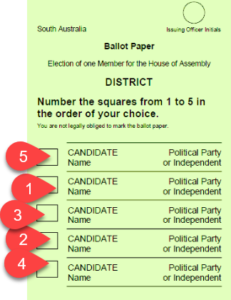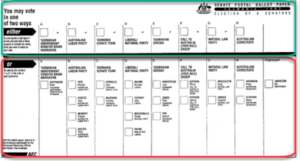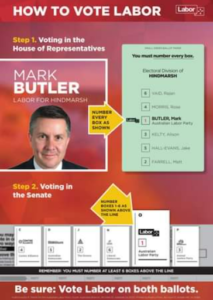By AM Benjamin
Background
A crucial step towards implementing ranked choice voting across the United States is to understand how this voting method has been leveraged in other democracies across the world. Fortunately for us, we need look no further than our neighbors down under. Australians have been using “Ranked Choice Voting” or as they call it “preferential voting” since 1919 to elect representatives at the State and Federal Level. For the purposes of this article, the focus will be on elections at the federal level in the Australian Parliament.
- The Australian Parliament’s Lower House, the House of Representatives, uses Single Winner Ranked Choice voting (Alternative Vote). Candidates from different parties compete for an individual house seat and the first candidate who reaches over 50% wins. If no candidate reaches over 50%, the lowest vote getting candidate is eliminated and their alternative votes are distributed across the remaining candidates, until a candidate finally reaches the 50% threshold.
- In the Upper House, called the Senate, Australia uses proportional ranked choice voting (STV). Candidates run in multimember districts and voters rank either parties or candidates. Based on these results, a certain number of candidates are allocated to this district based on the ranked votes.
- As a means of differentiating the two voting experiences, Australians have separate ballots for each house election. House of Representatives elections are conducted on a green ballot which shows a list of candidates to rank. Voters must rank all candidates on a House ballot or the ballot is invalid.

- Senate Elections are conducted on a white ballot which allows candidates to either rank the parties (above the line-see green box) or candidates (below the line-see red box). Unlike the House elections, election rules will designate a minimum number of rankings for parties (Ex. You must rank at least 6 parties) or candidates (you must rank 12 candidates).

- A unique feature of Australian politics is compulsory voting – eligible citizens must register and vote in elections. Furthermore, the requirement that a certain number of candidates and/ or parties are ranked differs from the current way RCV is implemented in the US (thus far). In the US, the ability to choose whether or not to rank certain candidates creates more opportunities for ballot exhaustion (unranked candidates) which allows for variability and unpredictability.
- The requirement of mandatory ranking and the fact that the House and Senate have different RCV voting methods (Alternative v STV) could potentially create a confusing voting experience. Fortunately, the Australian government has created an informative website that allows voters to see how to simulate voting for each election using sample ballots. In doing so, voters are able to simulate their voting experience to ensure they do not submit an illegitimate ballot.
Parties play a crucial role in helping voters rank and therefore form pre-electoral coalitions
- Political parties produce “How to Vote” cards which serve as recommendations to supporters of how to rank respective candidates/parties. Thus the rankings are sort of pre-decided by the parties. This forces parties to reach across the aisle and form alliances with others. For instance, voters of a minor party are likely to encourage their members to rank a major party highly if they feel that the major party can incorporate the minor party’s platform into their agenda.
- Usually, especially in the House of Representatives, the two major Australian parties (Liberal, the Center Right, and Labor, the Center Left) work with the minor parties to earn high rankings (thereby helping them potentially secure a seat). In doing so, the major parties could make concessions to the minor parties (i.e. offering to incorporate part of the minor parties’ platforms in a major parties’ agenda).
- While a lot of the tactics with respect to Australian RCV can involve a turf war between Labor and Liberal, in some cases, parties’ can leverage rankings to punish smaller parties. For instance, in a very unusual move, in 2013, Liberal Party leader, Tony Abbott, encouraged many of their voters to rank “Labor” over the Green Party as a means of reducing the number of Green Party Seats.

Caption: A sample of a “How to Vote” card for the Australian Labor Party. The top green ballot provides guidance to a prospective Labor Party voter on how to rank candidates after labor. The bottom ballot shows the “Above the Line” voting for parties for the Senate seat.
What the US can learn from Ranked Choice voting in Australia
- Candidates need to be active in creating “How to Vote” cards to better guide voters on how to make informed decisions on how to rank other candidates (or whether to not rank). In Australia, “How to Vote” cards are crucial for determining election results.
- We are starting to see these sorts of alliances in the United States. For example, in the Alaska Governor Election the Independent candidates and Democratic candidates banded together to form an alliance to encourage ranking one another in the election as second place choice over the incumbent Republican governor.
Sources:
Australian House of Representatives – Wikipedia
How does Australia’s voting system work? | Australian politics | The Guardian
Tony Abbott’s call to preference Labor threatens Greens’ only MP | Coalition | The Guardian
How To Vote – PETER MALINAUSKAS – South Australian Labor Party (alp.org.au)
Practise voting – Senate – Australian Electoral Commission (aec.gov.au)
Practise voting – House of Representatives – Australian Electoral Commission (aec.gov.au)
Lessons from Australia’s Ranked Choice Voting Election – FairVote
The views and opinions expressed in this article are those of the authors and do not necessarily reflect the official policy or position of Rank the Vote, its members, supporters, funders, or affiliates.

